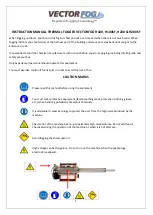
Important Safety Instructions
5
16. Use caution when installing or
modifying telephone lines to prevent
electrical shock and/or fire.
17. Unplug this product from the wall
outlet and refer servicing to qualified
service personnel under the
following conditions:
A. When the power supply cord or
plug is damaged or frayed.
B.
If the product has been exposed to
rain or water.
C.
If the product does not operate
normally by following the operating
instructions.
D.
If the product’s cabinet has been
damaged.
E.
If the product exhibits a distinct
change in performance.
18. Avoid using a telephone (other than
a cordless type) during an electrical
storm. There may be a remote risk
of electric shock from lightning.
19. Do not use the telephone to report
a gas leak in the vicinity of the leak.
20. Do not place this product on an
unstable cart, stand or table. The
product may fall, causing serious
damage to the product.
IF YOUR PRODUCT UTILIZES
BATTERIES, THE FOLLOWING
ADDITIONAL PRECAUTIONS
SHOULD BE OBSERVED:
1.
Use only the type and size of
battery(ies) specified in the user
manual.
2.
Do not dispose of the battery(ies) in
fire. They may explode. Check with
local codes for possible special
disposal instructions.
3.
Do not open or mutilate the
battery(ies). Released electrolyte is
corrosive and may cause damage to
the eyes or skin. It may be toxic if
swallowed.
4.
Exercise care in handling battery(ies)
in order not to short out the
battery(ies) with conducting
materials such as rings, bracelets, and
keys. The battery(ies) or conductor
may overheat and cause burns.
5.
Do not attempt to recharge the
battery(ies) provided with or
identified for use with this product
that are not intended to be charged.
The battery(ies) may leak corrosive
electrolyte or explode.
6.
Do not attempt to rejuvenate the
battery(ies) provided with or
identified for use with this product
by heating them. Sudden release of
the battery(ies) electrolyte may
occur causing burns or irritation to
eyes or skin.
7.
When replacing battery(ies), all
batteries should be replaced at the
same time. Mixing fresh and discharged
batteries could increase internal cell
pressure and rupture the discharged
battery(ies). (Applies to products
employing more than one separately
replaceable primary battery.)
8.
When inserting battery(ies) into this
product, the proper polarity or
direction must be observed. Reverse
insertion of battery(ies) can cause
charging, and that may result in
leakage or explosion.
XL665_IFU_US_EN.book Page 5 Friday, April 3, 2009 11:51 AM








































